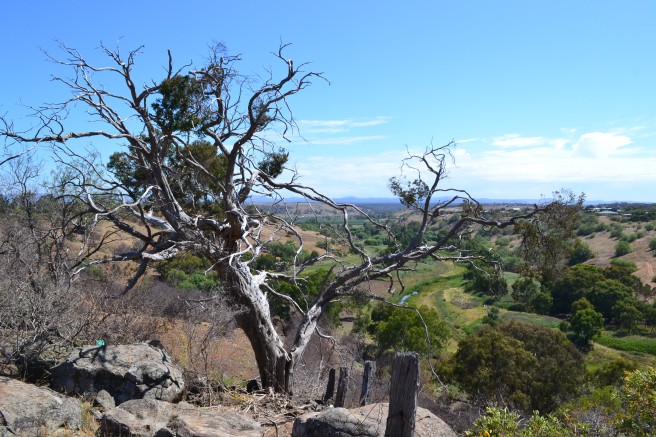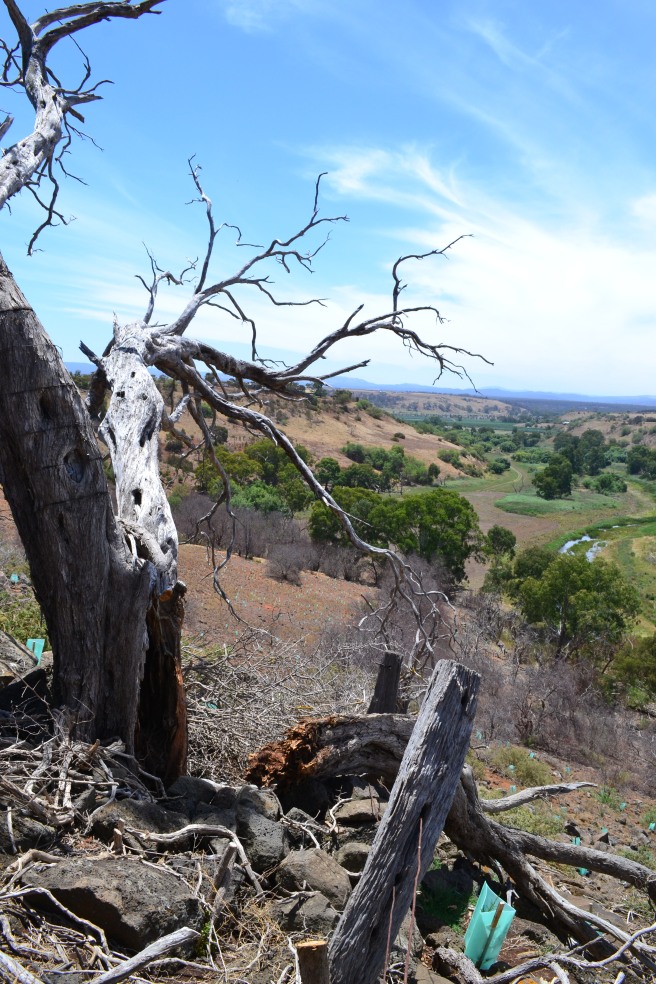Where the volcanic plains were cut through by the river, just east of Bacchus Marsh at Parwan Gorge, giant blocks of weathered basalt tumble over the edge of a precipitous, wind-blasted escarpment.
A harsh environment, on the edge of the fertile plains, above the fertile river valley, but vastly different from either. In this peculiar niche a special community lives: the escarpment shrubland. Crowning it all is a row of ancient Moonah trees (Melaleuca lanceolata).
`

These wizened ancients often appear dead at first glance. The multiple trunks are dry and brittle, no obviously living bark to be seen. But then a tuft of green leaves comes into focus. And then another. These branches must have just a thin strip of bark somewhere to keep the leaves connected to the roots.
I don’t know how long Moonah live. A Pacific Hydro employee at the Cape Bridgewater wind farm once told me the stands of Moonah there contain individuals well over 100 years old. And that’s where you’d typically find Moonah: on coastal outcrops and heaths. Why are they here, far from the sea?
The conditions of the escarpment can help us to understand why this coastal species does so well here. Like those sandy coastal soils, the edge of the escarpment is well drained, with water running off and over the rocks and down the steep slope, the heavy basalt soil of only a few metres behind the edge making way to a much more weathered, looser loam on the slope. Despite the low rainfall (much lower than Cape Bridgewater!) the boulders keep the soil cool and prevent evaporation – or excessive competition from other plants.
Plenty of locally unusual species grow on these escarpments: for example Buloke (Allocasuarina luehmannii), Cypress-pine (Callitris glaucophylla), which are hardy inland species. Werribee Blue-box (Eucalyptus baueriana subspecies Thalassina) wave their sea-green leaves lower down and on the south-facing slope, a tough and rare local variant of a species from eastern Victoria.
With the haven of the river below, a riot of different birds can be seen on the slopes, nesting, eating saltbush berries and nectar, Wedgetail Eagles soaring on the thermal updrafts. Reptiles and insects abound, black wallabies bound for cover, anthills are disrupted by echidna diggings. This harsh environment is teeming with life.
Parwan Landcare group are working to remove the massive infestation of weeds and revive this ecosystem. Thickets of African Boxthorn have taken over large sections of the escarpment (providing food and shelter for foxes and rabbits); Serrated Tussock is blanketing the grassy sections; and pepper trees and willows steal the moisture and sunlight. With these aggressive competitors slowly being removed, native vegetation is beginning to re-establish naturally. Moonah and other seedlings have been planted among the rocks up and down the hill to help heal the damage done. The work is hard, but the reward is a feast for the eyes that has to be seen to be believed.
(You can walk in the gorge, or go fishing; access is easily achieved from Hopetoun Park on the northern side).
UPDATE: A couple of days after the first photo was taken, strong winds felled one trunk of this old tree.

Never realised there was a stand of Moonah trees around Bacchus Marsh. It is interesting to note that in the Mallee of NW VIC we also find Moonah, Callitris and Bulokes. Together with the Long Forest Mallee it paints a picture how vegetation has changed. Was the gorge part of an old coastline?
LikeLiked by 1 person
That’s a good point, prior to the lava flows, Rowsely fault movements etc the area could well have been coastal at some point — I’ll have to look up the details. Bacchus Marsh today is about 100mASL. As you point out Moonah also live inland, I’ve surveyed them on the southern edge of Little Desert NP for botany class. Then again, that area was, in geological time, coastal (ish) as well.
LikeLike